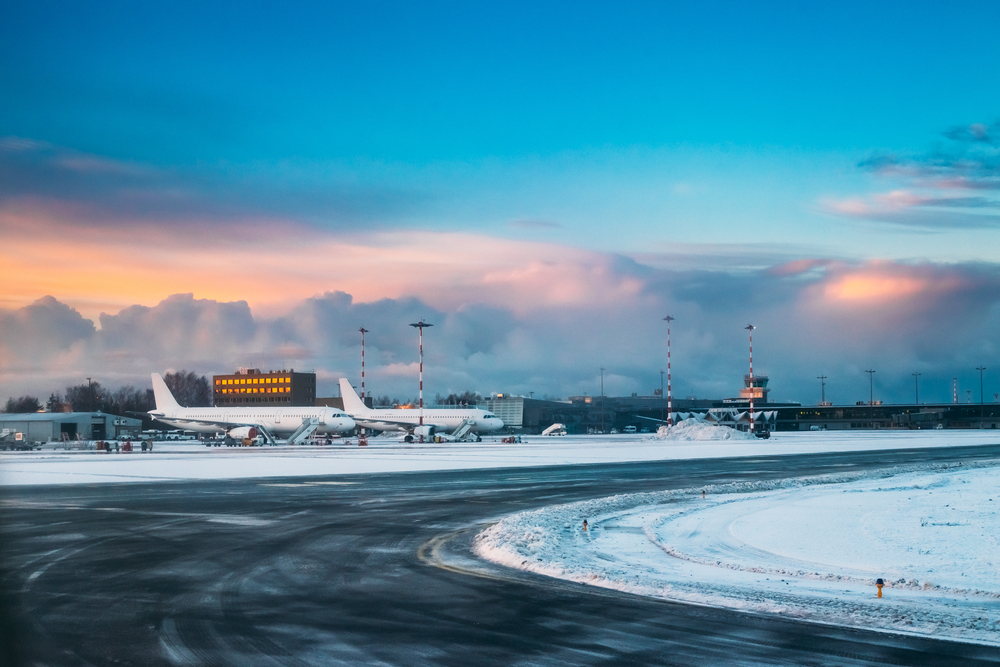Winter Weather Challenges Airport Operations

The Beast from the East hit the UK last week and had severe effects on some UK airports, in particular, Glasgow International which closed on Wednesday night, Bristol Airport and Edinburgh Airport both closed Thursday night, whilst Gatwick and Heathrow experienced some cancellations but remained operational. Could the airports have done more to prevent this? And could they learn from how other airports dealt with the winter season?
International Airport Review has released detailed reports on how airports across the globe deal with winter weather challenges – below I have highlighted a few which have developed their winter operations to minimise disruption.
Airports have dedicated teams that deal with winter and airport maintenance. Ted Stevens Anchorage International Airport (ANC) for example, has never closed due to a snow or ice storm which is an amazing feat considering the average annual snowfall in Alaska is 75 inches. Due to the prime location that ANC resides – within 9.5 hours flight time of 90% of the industrialised world, making it the sixth busiest cargo destination in the world – it is imperative that the airport operates smoothly at all times. They deal with this by having a team of 109 professionals, including equipment operators, mechanics, electricians and others (albeit this team is bigger than most airports due to the number of weather events they encounter per year, typically 65!). However, just having a team of this size does not guarantee the successful clearing and maintaining of the runways, it is completely down to planning, preparation and execution.
Another airport that deals with particularly extreme weathers in the winter season is Gerald R. Ford International Airport (GRR). This is due to the location of Lake Michigan (50 miles away), which means the airport suffers from lake effect snow, cold temperatures and icy conditions. The ability to effectively tackle these testing conditions is again down to astute planning and preparation! GRR looks at the lakes’ water temperatures in late autumn and into the winter months, as each snow and ice storm has its own unique characteristics and challenges. This means the airport’s snow removal team of 15 full-time members, two supervisors and 10 seasonal employees need to be like amateur meteorologists. To prepare even further, GRR takes into account the previous snow season’s performances to highlight where there are opportunities for improvement, whether that will be investing in new equipment, hiring more staff or engaging in further training. This is something that GRR does brilliantly as in the past it took 30 minutes to clear the runway, and by investing in new equipment they reduced this time to 9.6 minutes.
A bit more close to home I looked at Manchester Airport (MAN). The airport begins with consultation groups as early as April, which involve feedback, presentations and workshops to learn from previous experiences of winter so that they can plan in advance. MAN, in particular, uses a tool provided by the Met Office “Open Runway” which allows them to have a 24-hour look at the weather on the site, however, due to the size, it is sometimes difficult to predict as it can be snowing at one end of the runway and the other can be completely clear. To tackle this, MAN has sensors on the airfield to show the current ground temperatures which can be used to compare with predicted temperatures. However, due to the sheer volume of flights leaving the airport sometimes delays are inevitable, MAN has contingencies in place so that airlines can divert their arrivals to other airports that aren’t affected by the weather and visa-versa.
Technology is a massive part of airport management and it is no different for preparing and dealing with the challenges that winter brings. There are always advancements happening to deal with these issues, in particular, the development of automation and the use of robotics within winter operations equipment. This has been developed as the drivers of the vehicles need to be well trained as the operation of the equipment is becoming increasingly more complexed. Therefore, having one driver operating a fleet of vehicles can prove highly advantageous for an Airport, the fleet will have a pre-set route through GPS giving it an immediate advantage over manual driving which could be slowed down due to the low visibility in snowy conditions.
Investment in more advanced equipment is becoming more important for airports to tackle the winter season as Heathrow has shown by investing £36million since 2010. Another airport leading the way by investing is Denver International Airport (DEN), which has invested heavily since 2006 when a blizzard caused a 2-day closure. DEN now has about 250 pieces of airside snow-removal equipment for runways and an additional 120 for its landslide operations, on top of that, DEN utilises a contractor to deploy 10 snow melters that melt 600 tons of snow per hour. DEN has also implemented a De-icing Manager software which helps the airport and airlines predict the best time for each aircraft to push back from the gate taking into consideration runway conditions. Also, due to their investment, they have reduced the average time to clear a runway from 45 minutes to under 15 minutes. However, despite all this, in 2016 they were forced to close the airport for only the second time in its history due to weather conditions. It just goes to show that for all the planning, preparation and investment into preventing the conditions affecting the operations, sometimes, Mother Nature wins.